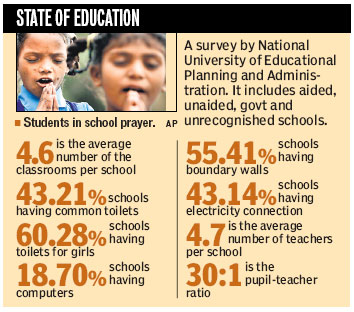Compulsory and freCompulsory and free education up to 14 years may have become mandatory with the
Supreme Court upholding the constitutionality of Right to Education (RTE) Act.
But a recent study reveals that schools across country continue to lack in basic
infrastructure facilities such as toilets, classrooms and teachers.
Conducted by National University of Education Planning and Administration
(NUEPA), the survey stated that only 62.61% of schools have common toilets.
Shockingly, only 72% of them are functional. Even the number of teachers per
school is a dismal 4.7.

The survey was recently submitted before Supreme Court by NUEPA that filed an
affidavit subsequent to court directions. The apex court is hearing public
interest litigation (PIL) on the pathetic condition of government schools in the
country.
The NUEPA survey, however, included aided, unaided, government and unrecognized
schools. The statistics has been generated through NUEPA's district information
system for education (DISE).
According to the survey the average number of classrooms per school is just 4.6.
While 42.59% schools have boys toilets, 60.28% have toilets for girls. All of
them are not in working condition, the survey revealed.
Even as the government plans to make available affordable tablets to students
for educational purposes, the study threw up somewhat startling facts regarding
computer education at school level. Only 18.70% schools in India have computers
and only 82% of them are functional machines.
More than fourty-five per cent schools do not have boundary walls, whereas only
43.14% have electricity connection.
The only silver lining in the report appears is on the admission front. Despite
schools' failure to improve the facilities, parents' desire to get their
children education hasn't died down. There has been a marginal increase in the
enrolment of students at the primary level. Compared to 2009-2010, around 18
lakh new students got admitted in classes I to V.